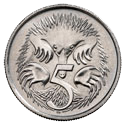
The Australian dollar is the official currency and legal tender of Australia, including all of its external territories, and three independent sovereign Pacific Island states: Kiribati, Nauru, and Tuvalu. In April 2022, it was the sixth most-traded currency in the foreign exchange market and as of Q1 2024 the sixth most-held reserve currency in global reserves.

The Kiribati dollar is one of the two official currencies of Kiribati. The Kiribati coins are pegged at 1:1 ratio to the Australian dollar, the other official currency of Kiribati. Kiribati coins were issued in 1979 and circulate alongside banknotes and coins of the Australian dollar. In present day, Kiribati coins are rare in comparison to Australian coins with the last minor emission made in 1992, and these old coins are now generally collectors items. The complete emissions of coins were made in 1979 and in 1989 for the tenth anniversary of independence.
The coins of the Fijian dollar have been part of the physical form of Fiji's currency, the Fijian dollar.

The twelve-sided Australian fifty-cent coin is the third-highest denomination coin of the Australian dollar and the largest in terms of size in circulation. It is equal in size and shape to the Cook Island $5 coin, and both remain the only 12-sided coins in the southern hemisphere. It was introduced in 1969 to replace the round fifty-cent coin issued in 1966.
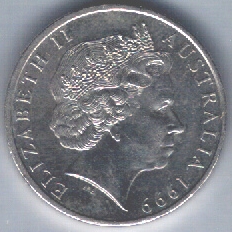
The twenty-cent coin of the Australian decimal currency system was issued with conversion to decimal currency on 14 February 1966, replacing the florin which was worth two shillings, a tenth of a pound.
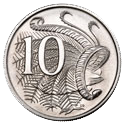
The Australian ten-cent coin is a coin of the decimal Australian dollar. When the dollar was introduced as half of an Australian pound on 14 February 1966, the coin inherited the specifications of the pre-decimal shilling; both coins were worth one twentieth of a pound and were called "bob". On introduction it was the fourth-lowest denomination coin. Since the withdrawal from circulation of the one and two cent coins in 1992, it has been the second-lowest denomination coin in circulation.
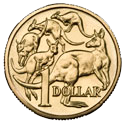
The Australian one-dollar coin is the second most valuable circulation denomination coin of the Australian dollar after the two-dollar coin; there are also non-circulating legal-tender coins of higher denominations.
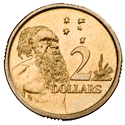
The Australian two-dollar coin is the highest-denomination circulating coin of the Australian dollar. It was first issued on 20 June 1988, having been in planning since the mid-1970s. It replaced the Australian two-dollar note due to having a longer circulatory life. The only "mint set only" year was 1991.

Christopher Ironside OBE, FRBS was a British painter and coin designer, particularly known for the reverse sides of the new British coins issued on decimalisation in 1971.

The Australian twenty-dollar note was issued when the currency was changed from the Australian pound to the Australian dollar on 14 February 1966. It replaced the £10 note which had similar orange colouration. There have been only three different issues of this denomination: a paper note which had a gradient of yellow and red, with a distinct orange background, and two designs of polymer note which can be recognised for their distinct red-orange colouration, and so it was nicknamed a "lobster". The first polymer note was issued on 31 October 1994 and the Next Generation polymer banknote was issued on 9 October 2019.

The Australian ten-dollar note was one of the four original decimal banknotes that were issued when the currency was changed from the Australian pound to the Australian dollar on 14 February 1966. It replaced the Australian five-pound note, which included the same blue colouration. There have been four different issues of this denomination: a paper banknote; a commemorative hi-polymer note, to celebrate the bicentennial of Australian settlement ; the 1993–2017 polymer note; and from September 2017 a polymer note featuring a transparent window.

The cent, formally the one-cent coin, was the lowest-denomination coin of the Australian dollar. It was introduced on 14 February 1966 in the decimalisation of Australian currency and was withdrawn from circulation in 1992. It is still minted as a non-circulating coin. A one-cent coin in 1966 would have a purchasing power equal to about 16c in 2023 values.
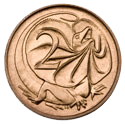
The Australian two-cent coin was introduced in 1966 and was the coin of the second-lowest denomination until it was withdrawn from circulation in 1992. It is still counted as legal tender, but is subject to some restrictions, and two-cent coins are legal tender only up to the sum of 20 cents.
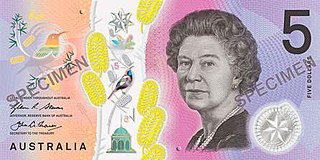
The Australian five-dollar note was first issued on 29 May 1967, fifteen months after the currency was changed from the pound to the dollar on 14 February 1966. It was a new denomination with mauve colouration – the pre-decimal system had no denomination with a value of £21⁄2. The first polymer version of the note was introduced on 7 July 1992. A major design update was issued on 1 September 2016, with a minor update to the signatures in 2019.

The round fifty cent coin was the highest-denomination and largest diameter coin of the Australian decimal coins, introduced in 1966. It has a nominal value of half an Australian dollar, equivalent to five shillings in the pre-decimal accounting system. Due to the large number minted in 1966, and the rising cost of silver, it was not made in any other year. It was replaced by a twelve-sided 50 cent coin in 1969, which retained its reverse of the Australian Coat of Arms.
The coins of the Australian dollar were introduced on 14 February 1966, although they did not at that time include the one-dollar or two-dollar coins. The dollar was equivalent in value to 10 shillings in the former currency.
The coins of the New Zealand dollar are used for the smallest physical currency available in New Zealand. The current denominations are ten cents, twenty cents, fifty cents, one dollar and two dollars. The $1 and $2 coins are minted in a gold colour, the 20c and 50c coins are silver colour and the 10c coin is plated in copper.

The Australian sixpence circulated from 1910 up until the decimalisation of Australian Currency in 1966. The coins were initially minted in England; however, Australia began to mint their own from the year of 1916 at branches of the Royal Mint in Sydney and Melbourne. The coins which made up Australia's pre-decimal currency were identical to British currency in the characteristics of weight and size. The Coinage Act of 1909–1947, authorised the issue of Australian coins in the select denominations, including the sixpence. By 1916 all silver denominations, including the sixpence, could be minted at the Royal Mint branch in Melbourne. Unique Australian currency was created with decimalisation in 1966.

The Australian pre-decimal halfpenny coin, commonly known as a ha’penny, was the smallest denomination of the Australian Pound in circulation. It was a unit of currency that equalled half of a penny, 1/24 of a shilling, or 1/480 of a pound. The coin was made to be equivalent to the British halfpenny; its dimensions, composition and values were equivalent, and additionally, the two currencies were fixed at par.

Coin roll hunting is the hobby of searching and sorting coinage pulled from circulation for collectible coins. This is achieved through obtaining rolled coin, boxed coin, or bagged coin from banks and credit unions. A variant of this practice involves banknotes and is carried out in essentially the same fashion, normally to search for unusual serial numbers, star notes, and misprints.
